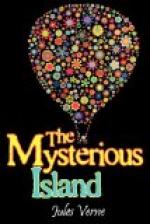But if the engineer and the boy were obliged to give up thoughts of following a circular direction, in return an opportunity was given for ascending the cone.
In fact, before them opened a deep hollow. It was the rugged mouth of the crater, by which the eruptive liquid matter had escaped at the periods when the volcano was still in activity. Hardened lava and crusted scoria formed a sort of natural staircase of large steps, which would greatly facilitate the ascent to the summit of the mountain.
Harding took all this in at a glance, and without hesitating, followed by the lad, he entered the enormous chasm in the midst of an increasing obscurity.
There was still a height of a thousand feet to overcome. Would the interior acclivities of the crater be practicable? It would soon be seen. The persevering engineer resolved to continue his ascent until he was stopped. Happily these acclivities wound up the interior of the volcano and favored their ascent.
As to the volcano itself, it could not be doubted that it was completely extinct. No smoke escaped from its sides; not a flame could be seen in the dark hollows; not a roar, not a mutter, no trembling even issued from this black well, which perhaps reached far into the bowels of the earth. The atmosphere inside the crater was filled with no sulphurous vapor. It was more than the sleep of a volcano; it was its complete extinction. Cyrus Harding’s attempt would succeed.
Little by little, Herbert and he climbing up the sides of the interior, saw the crater widen above their heads. The radius of this circular portion of the sky, framed by the edge of the cone, increased obviously. At each step, as it were, that the explorers made, fresh stars entered the field of their vision. The magnificent constellations of the southern sky shone resplendently. At the zenith glittered the splendid Antares in the Scorpion, and not far was Alpha Centauri, which is believed to be the nearest star to the terrestrial globe. Then, as the crater widened, appeared Fomalhaut of the Fish, the Southern Triangle, and lastly, nearly at the Antarctic Pole, the glittering Southern Cross, which replaces the Polar Star of the Northern Hemisphere.
It was nearly eight o’clock when Cyrus Harding and Herbert set foot on the highest ridge of the mountain at the summit of the cone.
It was then perfectly dark, and their gaze could not extend over a radius of two miles. Did the sea surround this unknown land, or was it connected in the west with some continent of the Pacific? It could not yet be made out. Towards the west, a cloudy belt, clearly visible at the horizon, increased the gloom, and the eye could not discover if the sky and water were blended together in the same circular line.
But at one point of the horizon a vague light suddenly appeared, which descended slowly in proportion as the cloud mounted to the zenith.




